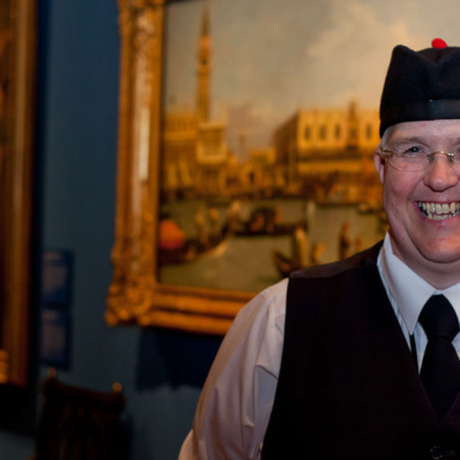Following the execution of Charles I in 1649, the greater part of the King's magnificent possessions were sold by order of Oliver Cromwell, and the Royal Collection has largely been formed since the Restoration of the Monarchy in 1660.
The Royal Collection is not owned personally by The King, but is held in trust by him as Sovereign for his successors and the nation.
Royal Collection Trust, one of the five departments of the Royal Household, is responsible for the care of the Royal Collection and manages the public opening of the official residences of His Majesty The King – Buckingham Palace, Windsor Castle and the Palace of Holyroodhouse in Edinburgh. Income generated from admissions, retail sales and other commercial initiatives funds the conservation of the Royal Collection and projects to increase access to and enjoyment of the Collection and the Palaces.

Seeing the Royal Collection
The Royal Collection includes the contents of 13 royal residences and former residences across the UK, most of which are regularly open to the public, enabling visitors to enjoy the works of art in the historic settings for which they were originally acquired many centuries ago. Aspects of the Collection are also shown at The Queen's Galleries in London and Edinburgh in a programme of temporary exhibitions.
Touring exhibitions and loans to institutions worldwide are part of a commitment to broaden public access and show works of art in new contexts. Some 15,500 items from the Collection are on long-term loan to more than 150 museums and galleries in the United Kingdom and abroad, including the British Museum, The National Gallery, the Victoria and Albert Museum, the Museum of London, the National Museum of Wales and the National Gallery of Scotland.

Over 260,000 items from the Royal Collection can be viewed on the Royal Collection Trust website, where records can be browsed by creator, commissioner, acquirer, subject, material, technique, location, date and catalogue number. A unique map tool, The Royal Collection Near You, enables visitors to discover connections between their local area and works of art in the Royal Collection. Royal Collection Trust's What's On guide shows upcoming events at The Queen's Galleries and the royal residences.

Charles I by Van Dyck
On his appointment as Principal Painter to Charles I in 1632, the Flemish artist Van Dyck - Rubens's most gifted follower - was required to specialise in portraiture. This is one of the chief paintings to result from his appointment, which revolutionised British painting and provided us with the enduring image of the Stuart court.
View on the Royal Collection website










